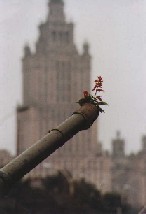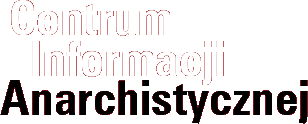LESSONS OF THE AUGUST PUTSCH
 On Aug. 19, 1991, one of the most important events in 20th century history took place: communists coup makers who wished to overthrow Mikhail Gorbachev, to undo reforms and ensure party rule in the Soviet Union were met by mass resistance which led to the Soviet Union’s collapse.
On Aug. 19, 1991, one of the most important events in 20th century history took place: communists coup makers who wished to overthrow Mikhail Gorbachev, to undo reforms and ensure party rule in the Soviet Union were met by mass resistance which led to the Soviet Union’s collapse.
Nowadays, this event has remarkably almost faded into obscurity and accounts of it have been altered to reflect an official version most palatable for mass consumption. However this article is not to be a historical relation, but rather a reflection, written by a participant in the events. As with any historical event, what is most important is what one can learn from it.
There can be many lessons drawn from the putsch and perhaps the most important question of all is whether or not there could have been an alternative to the crappy choice of Yeltsin, Gorbachev or the GKChP (putschmakers). This last question is perhaps too ambitious to undertake in any small article, hence I will limit myself to three observations and lessons: 1) that the media almost pathologically must present leaders and create a top-down version of events; 2) that it doesn’t pay to fight on the side of the state or leaders, even if one side seems better than another; 3) anarchists have no place in the labour movement besides their rightful one in the rank and file – any attempts to force changes from above will end badly.
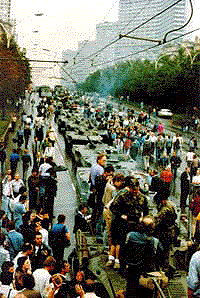 Tanks on Kalininsky Prospekt (Novy Arbat) meet resistance.
Tanks on Kalininsky Prospekt (Novy Arbat) meet resistance.
1. The Media, Yeltsin and the Tank
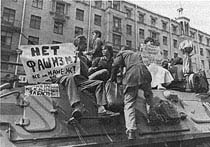 Sometime in the morning of Aug. 19, I was arranged with a friend from the Confederation of Anarcho-Syndalicasts to meet at Lenin Library when somebody came in claiming their were tanks on Leninisky Prospekt. If one had been following the news carefully, there were clear hints (especially the attempted coup in June) that some people would like to see Gorbachev ousted. Despite this, the appearance of a huge number of tanks in Moscow came as a surprise to most people.
Sometime in the morning of Aug. 19, I was arranged with a friend from the Confederation of Anarcho-Syndalicasts to meet at Lenin Library when somebody came in claiming their were tanks on Leninisky Prospekt. If one had been following the news carefully, there were clear hints (especially the attempted coup in June) that some people would like to see Gorbachev ousted. Despite this, the appearance of a huge number of tanks in Moscow came as a surprise to most people.
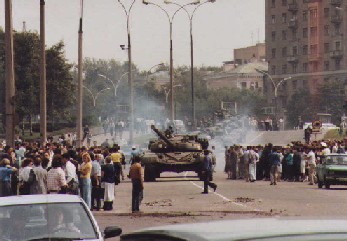 We went in a car to the center of the city, noticing the military might gathered in the capital. The sight of it was rather scary. I might have been scared if not for the fact that I had faced tanks in Belgrade just a few months earlier and somehow now had a completely different relation to tanks. We tried to put on the radio. Swan Lake. The Nutcracker. While the whole city was trying to get news, the stations were sending the psychomanipulative sounds of Tchaikovsky.
We went in a car to the center of the city, noticing the military might gathered in the capital. The sight of it was rather scary. I might have been scared if not for the fact that I had faced tanks in Belgrade just a few months earlier and somehow now had a completely different relation to tanks. We tried to put on the radio. Swan Lake. The Nutcracker. While the whole city was trying to get news, the stations were sending the psychomanipulative sounds of Tchaikovsky.
We finally got to the center and I met my friend at the library. What we noticed immediately was that thousands of people had decided that today was THE DAY for resistance, the historic and decisive moment in their history when they would either go back to the authoritative one-party rule of the Soviet Union – or rebel. The people were marching in the streets, trying to gather, to do something. There were no leaders. Very few actually had any idea of what to do. Except be there and resist.
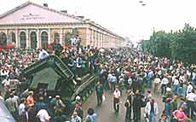 Manezh. Sq.
Manezh. Sq.
We went to Manezh Sq.. This was the time before they built a hideous shopping mall there and it was a huge meeting and demonstration place. We noticed that people were yelling at or talking to soldiers in tanks. Somebody had painted “pozor” (wstyd) on one of them. Other people had decided to take trolleybuses off their lines and push them into Manezh Sq. and put them in front of the tanks. This seemed like a good idea to us, so we helped in these actions for a time. People were climbing up on the buses and making speeches to the others. We called for everyone to get their friends and families together and participate in the direct actions. Maybe even organize a revolution.
It continued like that all day. The later it got, the more people arrived. This was not the era of the mobile phone. People were lining up at pay phones, trying to call and inform friends that something was happening.
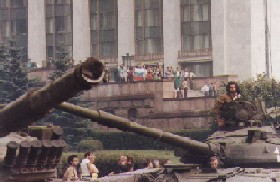 White House. Morning, Aug. 19, 1991.
White House. Morning, Aug. 19, 1991.
It was only a week or more after the putsch that I got a hold of some Western newspapers and heard an interesting story about Yeltsin. According to it, Yeltsin had organized the mass resistance by standing on a tank at the White House and rallying people to resist the putsch. That’s why the people came out and acted. The problem with that story is that it’s not only not true – but the people who told it even knew that.
As I later learned, Yeltsin did appear at the White House with a small group of people in order to do a press conference for CNN. At 12:00. Hours after tens or thousands of people were already mobilized. He stood on a tank and incited resistance. And this image was broadcast all over the world. Only one small detail: it wasn’t broadcast in Russia. In Russia, the stations were largely quiet, and only late at night did any news get out that there were some people who were resisting the coup in Moscow. Late at night. But the actual resistance started early in the morning. Nobody knew anything about Yeltsin. It wasn’t possible. Only a very select few places in Moscow were allowed to have access to CNN. And of course CNN reporters knew this – they saw all the events, but consciously decided that it would be a better story to present Yeltsin as the leader of events against the coup. After all, it was clear that it was he who was the only person who might emerge as the nation’s new leader.
 There is even one “scholarly” work about the role of the media in the putsch. It tries to maintain its thesis that the media mobilized the resistance by pointing out that at 9PM, Vremya (news program) came on and talked about how the country is sinking into “anarchy”. Then suddenly, the TV showed a bit of what anybody who had bothered to leave the house had already seen at 8AM. The people speaking with the soldiers. The trolleybuses blocking the tanks. The people standing on them on Manezh Sq. inciting the crowd. Then, finally, Yeltsin on a tank saying that there was a coup d’etat and people building barricades at the White House. In such a combination, it might have also appeared to some people that Yeltsin was the new Lenin, calling people to revolution. What is interesting is that despite again the clear knowledge of the scholar who wrote this work that people had moved and mobilized themselves long before any TV station sent them any idea to do it, she maintains the angle of the power of the media to mobilize instead of examining the power of people to mobilize themselves without the media, which they clearly did.
There is even one “scholarly” work about the role of the media in the putsch. It tries to maintain its thesis that the media mobilized the resistance by pointing out that at 9PM, Vremya (news program) came on and talked about how the country is sinking into “anarchy”. Then suddenly, the TV showed a bit of what anybody who had bothered to leave the house had already seen at 8AM. The people speaking with the soldiers. The trolleybuses blocking the tanks. The people standing on them on Manezh Sq. inciting the crowd. Then, finally, Yeltsin on a tank saying that there was a coup d’etat and people building barricades at the White House. In such a combination, it might have also appeared to some people that Yeltsin was the new Lenin, calling people to revolution. What is interesting is that despite again the clear knowledge of the scholar who wrote this work that people had moved and mobilized themselves long before any TV station sent them any idea to do it, she maintains the angle of the power of the media to mobilize instead of examining the power of people to mobilize themselves without the media, which they clearly did.
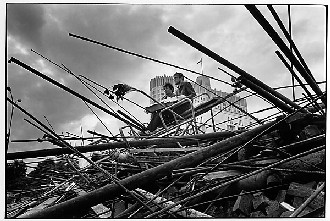 I saw none of this TV report – I was on a barricade. As a matter of fact, we started to build the first one in front of the White House – with building materials which were laying in the road in front of the American Embassy. We had met with some anarchists earlier and this idea of going to the White House spread. Not because Yeltsin told anybody – but it seems a natural place to go. We had got there earlier than some others – maybe 6:00 or 7:00. People were just arriving. By 9:00, all the others got there. All the politically active people had somehow been informed and word was spreading around the streets. Some people just guessed that something might be there. By the time the news had been broadcast, there must have been at least 100,000 people already there and the barricades were already up.
I saw none of this TV report – I was on a barricade. As a matter of fact, we started to build the first one in front of the White House – with building materials which were laying in the road in front of the American Embassy. We had met with some anarchists earlier and this idea of going to the White House spread. Not because Yeltsin told anybody – but it seems a natural place to go. We had got there earlier than some others – maybe 6:00 or 7:00. People were just arriving. By 9:00, all the others got there. All the politically active people had somehow been informed and word was spreading around the streets. Some people just guessed that something might be there. By the time the news had been broadcast, there must have been at least 100,000 people already there and the barricades were already up.
Despite this, and despite the events of the following days, usually coordinated in a decentralized manner, the official history of the August putsch will always remind us that Yeltsin called on the people and the people responded. After all, who could possibly understand that people can self-organize without political leaders.
2. The end result showed us our mistakes
 Despite what we intended to accomplish, the end result was that Yeltsin came into power. Nothing good. Such a defender of democracy that two years later, he had dissolved the parliament and used tanks and snipers to kill hundreds of defenders of democracy and scores of innocent bystanders.
Despite what we intended to accomplish, the end result was that Yeltsin came into power. Nothing good. Such a defender of democracy that two years later, he had dissolved the parliament and used tanks and snipers to kill hundreds of defenders of democracy and scores of innocent bystanders.
It’s not that anarchists supported Yeltsin – although maybe some of them saw him as the fateful and deceptive “lesser evil”. But it’s not enough to be against something – like the authoritarian rule which the GKChP represented. In such a situation, the role of the anarchist is not only to be “against”, but to agitate for the destruction of government altogether – to plant an idea of a self-managed alternative which can replace the government and its leaders. But just at the point when it was clear that the event would be hijacked by Yeltsin and a new government, the anarchists failed to do anything but go along with the popular tide.
The anarchists were actually split into three major groups; I stayed in the one right next to the White House out of some idea that it was the most exciting and important place to be. The group we were in included members of the Democratic Union, who are liberals, not anarchists – although a couple of them came to our side.
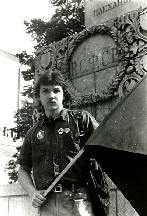 The guy who taught the kids to make Molotovs
The guy who taught the kids to make Molotovs
The first concern I had was to get some sort of weapons as the tanks were likely to come and attack. There I met one now famous character who was walking around with a big bunch of kids, aged maybe 8-12. We decided to make Molotov cocktails, only the problem was that in those days, there was no garbage anywhere – no place to get bottles. All bottles were scrupulously recycled. So getting bottles actually involved stealing them from the recycling. With these hard-found bottles, we needed gasoline, which is where the children came in because they were somehow able to put their tiny hands into gas tanks, or to suck some gas out and spit it into the bottles. So the children filled up the bottles with petrol and I tore up my pink T-shirt into rags for the finishing touches. (It was this pink material which identified the Molotovs history. One of them wound up in the Museum of the Revolution. The Molotovs were stolen later that night. As I later found out, Yeltsin’s security guards stole them from us outside the White House to protect the VIPs inside the White House.)
We had a few lead pipes. People started to break up the concrete in front of the White House for projectiles. But as it later turned out, when the tanks finally came, they decided to be on “our side”.
In the middle of all this, different people started to arrive and wanted to get onto the White House side of the barricades, but access had to be limited. Therefore, is somebody wanted to come up, a group of people had to go down, check them out and escort them. There was some general chaos and on some barricades, people just came up and on others, people were checked and turned away. At one time I went with a group of people to “protect” somebody, but when I got there, I immediately recognized that the person we were asked to escort was Edward Shevrednaze. But OK – I though if he wants to sit on barricades… Only he wanted to go into the White House. When we got there to the main doors, we noticed that they were gathering politicians there inside and they had some security force, etc. So I thought – shit – why are we staying out here like sitting ducks when we could go inside the White House. (We still weren’t sure that we wouldn’t be attacked by the army.) And wouldn’t it be better for anarchists, now that we see that there are leaders looking to form a new elite hiding out behind us, just to storm the White House and send a message that we don’t want a regime change – we want a revolution? And actually, there was nothing stopping us. Inside the White House was maybe one weapon. (That’s why they even stole our Molotov cocktails.) There were a couple of tanks outside – and we could have taken them easily. As a matter of fact, the Molotov kids had taken them over and were playing with them. But there was one problem. Nobody wanted to do it. Somehow people convinced themselves that the biggest goal was just the opposition to the communist government.
On the second day, it was already too late. A bunch of crazy ex-military men arrived and decided to try and organize the resistance. They set up a table and told everyone of the barricades that they have to come and sign up, and be assigned a division, a leader, etc.. Our side of the White House, filled with anarchists and liberals, just refused to cooperate with those self-proclaimed organizers.
Some of them came and were yelling at us that we had women and children there. Again, we told them to fuck off. But they decided to set up some people at the barricades to prevent non-registered people, including women and children from coming. At one time I had to jump to the other side of the barricades to go to the bathroom and coming back I was accosted by one of those folks but since I had a lead pipe, I just hit him and went back. Some time later, the self-styled leaders had had “complaints” about us, and came and told us that they organized us themselves.
In the meantime, all sorts of people were driving up in trucks. People from factories were stealing their production and bringing food and supplies to the barricades. A few guns arrived. Some people brought explosives. They decided that anarchists must be the ones who know something about it and they left them with us. Somebody brought me a gas mask. The self-professed organizers were getting nervous. They didn’t want the anarchists to get guns. They came and told us that we were a brigade and told us who our leaders were. It would have been amazingly funny if so many other people hadn’t just decided that this self-imposed leadership was a good thing.
Somehow the rumour had been circulating that I was a VIP – in fact, one of the leaders of the Lithuanian protests. It was a case of mistaken identity but it made me third in charge of that side of the White House. Of course we ignored this all – but in fact, our presence there was now stupid and useless. Things were destined to go in one direction and it did.
That isn’t to say that there weren’t spontaneous, self-organized events later. There were. People took down the statue of Dzerzhinsky and demanded the release of some political prisoners. They were even released right then and joined the action.
Perhaps the fact of the matter is that people fear that the people are not ready for revolution and won’t know how to govern themselves, so they don’t even try. In the end, we saw that many people who had been self-organizing themselves in mass direct action for 24 hours where happy that some force of order came and took down all their names, told them which brigade they should be in, who were their leaders and what they should do. But they just might as well have realized that they were an awesome self-organized force that didn’t need that bullshit. In any case, regardless of the outcome, we failed to make a lasting impression that indeed we were fighting for something else. So til this day, I am ashamed to admit that I am one of those people who defended the White House so that Boris Yeltsin could become president and Yegor Gaidar could impose shock therapy on the people and the nomenclatura could rob the national wealth and create a caste of oligarchs who would later rule the country.
By the time Yeltsin attacked the White House in 1993, most anarchists had learned this lesson and refused to defend it or to give a shit whether or not the legitimate president of the country was Yeltsin or Rutskoi.
3. Unions belong to the rank and file
On the day of Aug. 19, anarchists planned to meet in the afternoon at the former Ploschad Nogina, (Kitai Gorod) in the metro station in front of the statue of Nogin.
The largest group at that time was the Confederation of Anarcho-Syndicalists (KAS), although there were others. This meeting was with KAS.
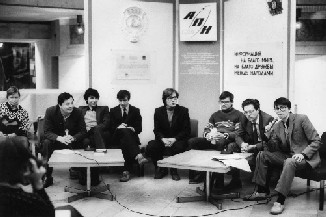 Andrei Isayev in the middle. Molotov Man to his left.
Andrei Isayev in the middle. Molotov Man to his left.
KAS was founded in 1989 and by 1991 had about 2000 members. But a good deal of them were not committed anarchists; many had been drawn into KAS by the reputations of some of its leaders, which was legendary during the glasnost era. It was one of the most important social movements of that time.
It is hard to imagine those times nowadays, hence it might be incredible to imagine the topic of the discussion. Indeed, most people at the meeting were quite surprised.
Many people were under the sway of Andrei Isayev whose only credit was the fact that indeed he was one of the first people to introduce anarchist ideas to many people. When Isayev talked, people listened. Even when he was talking bullshit. He had that type of authority which has usually proven to be disastrous for the anarchist movement. In fact, it was clear to me and to some others that Andrei Isayev, was a careerist son of a bitch.
On that day, when I thought people might have some ideas about what to do in the given situation to mobilize people to action, and maybe to expose them to some of our ideas, Isayev had another idea. He told us that after the Soviet Union collapsed, the old union functionaries would be ousted. (In Soviet days, there was only one huge official union which played the function of giving the worker everything – and keeping them all in line to maintain the Soviet workforce in servitude. The FNPR, which was recreated in 1990 as an attempt to have a federated structure, in fact kept most of the property and the privileges of the old official union, including automatic deductions from workers’ pay.) So the old union functionaries had decided that it would be better if somebody else take over the parts of the union structure. The anarchists could in fact move into different areas of the leadership of one of the richest and most powerful labor organizations on the planet. 50 million members.
Looking back at it, it reads today almost like science fiction that the union bureaucrats would want to bring a fold of anarchists into the body in order to reform it and probably the event had fictive elements. My deep suspicions say that they knew all along that the careerists could be bought and only the appearance of new people, who mostly in fact had no say in anything, would keep the property of the FNPR intact.
A heated discussion followed. For some people, who opposed the existence of this union federation and the very idea of unions with later, this was the last straw. After Aug. 1991, people began to leave KAS en-masse; those who were committed anarchists invented a number of other groups – one of them eventually evolved into the current Russian section of the IWA. By the end of the year, KAS membership had dropped to probably no more than 200 people.
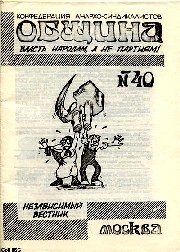 Obshchina. Legendary Samizdat zine from KAS.
Obshchina. Legendary Samizdat zine from KAS.
In fact, I was strongly against the plan and was one of a couple of people who walked out and instead went to build barricades. Later we found out that the role that some anarchists agreed to was to make a union newspaper. Most people felt that this was a quite harmless thing to do.
In fact, my closest friends were hired as staff and I worked in the building, so I was present at the unfolding of developments. Many quite talented people were hired to write, edit, draw and layout the paper, whose circulation skyrocketed from about 4000 to 40,000 practically overnight. The paper had potential – I even wrote a few things for it. But at the time, other things were going on as Isayev and other people from the left were building their careers in the trade union bureaucracy. The corruption had started. It started as little stuff – which Isayev helping himself to union property. This started very small (the first item of contention being a VCR) but in years to come grew completely out of control, with him and others diverting union funds to run a casino.
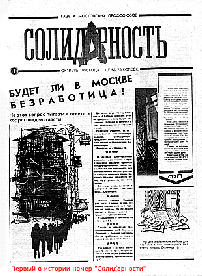 Solidarnost. Anarchists made the newspaper work. Despite the big A - there was no anarchism at the paper.
Solidarnost. Anarchists made the newspaper work. Despite the big A - there was no anarchism at the paper.
Some people had decided that instead of working with official unions, they’d set up an agency to promote independent unions. This was KAS-KOR, which I later worked with. (The name KOR inspired by Polish KOR. Later Polish workers would complain to us about how they were being repressed by Jacek Kuron.) KAS-KOR was located on the other side of the stairs from the Moscow Trade Union Federation (part of FNPR) and on the same floor as Solidarity, so in fact, old friends working in different directions met each other daily.
Problems with authoritarianism soon started as some of the anarcho-syndicalists set themselves up as bosses – because in fact, people were being paid for their union work. Isayev was, among other things, the editor of the FNPR paper – which meant that despite the fact that a large group of people did all the work, and despite the fact that he claimed to be an anarcho-syndicalist, he saw himself as the boss. The truth was finally exposed – there was nothing collectivist to the project. Isayev, who was busy helping himself to union property, was for example, not at all happy that after work anarchists met at the newspaper to use computers to make other samizdat publications on the state of the art Word for DOS programs at a time when nobody even dreamt of owning a computer. In fact, this was one of the things that pushed the workers to rebel more than anything; we showed up on Sunday to work on samizdat and found a lock on the door. After axing the thing, we found out that the zines had been deleted – because Isayev couldn’t tolerate that sort of thing going on at work. The workers decided to form a union.
That was sometime at the end of 1992 – beginning of 93. It was one of the craziest circuses I had ever witnessed. KAS-KOR had a radio program and was interviewing the workers. The main question – should the union of workers at the union paper belong to that union or by independent? The answer from Isayev and the union --- no union allowed. Threats. Screaming. People left. Some people were later fired. New people were hired who couldn’t make the paper. The circulation fell from 40,000 to 20,000 within months, and even then, that was just the print run. Thousands of copies laid unsold and undistributed in the FNPR offices. By 1993, the paper went out of public distribution and was only read by union bureaucrats.
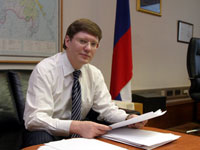 Fat Cat Isayev.
Fat Cat Isayev.
During the 1993 coup, the FNPR had originally called for resistance against Yeltsin. Yeltsin responded that he was thinking of splitting up some things, privatizing some of its property and liquidated some of its privileges, like the automatic union deductions which it lived off of. FNPR changed its tone and became pro-Yeltsin. Its leaders made big political careers and enjoyed the unions’ fortunes. (Even though its membership was falling.) Isayev is the most powerful man in Russian labor now - the head of the Duma Committee on Labour and Social Policy in Putin’s government.
KAS-KOR also went to shit quite quickly. The boss hierarchy also was imposed and when money came into play, it got worse because who controls the money, has the money. A couple of people moved from the FNPR paper to KAS-KOR, which produced information on the labour movement in Russian, English, French and Spanish and, among other things a magazine in English which they misappropriated funds from. One person from KAS-KOR eventually defrauded the Swedish SAC of $32,000 and it started to take money from CIA fronts. With these developments the anarchists had to quickly move out of it as well.
In fact, the “union period” 1991-1993 was a nightmare of everything that should not happen to anarchists. A good portion of them convinced themselves that the best thing they could do at the time was to work “inside the unions” and try to “reform them”. But even attempts to create a publication more attractive for the rank and file did not involved the rank and file. It involved a vanguard telling the rank and file how to think. It did not engage them in a dialogue with them. The leading anarchist figures, who had built their reputations on promoting the theory of anarchism, could not put it into place when they had a chance because they got drunk with their own power and privilege. They began to move in authoritarian left circles and see their former colleagues as impractical dreamers who “didn’t understand” what they saw to be true – that the best way to “help the workers” was to get into the government to ensure that pro-worker policies were in place. And for this wonderful service of protecting the working class, they were basically entitled to use collective property as they saw fit. It was the least the working class could do in exchange for protecting its interests.
The problem was not with corruption, but the whole idea that you can build a workers’ revolution from the top up. Unfortunately, we can see that around the world, there are still a fraction of anarchists who just don’t get this.
Laure Akai
August 19, 2006
